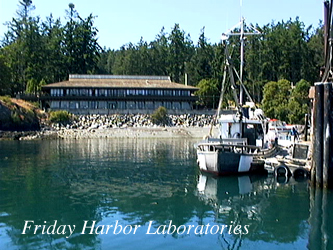 Site
map
Site
map
As part of a group
project for the Summer 2000 Marine Invertebrate Zoology class at the Friday
Harbor Laboratories, this page was developed to document some of the diversity
and natural history of the plankton in Puget Sound, Washington, around
San Juan Island.
 Site
map
Site
map
What
is plankton?
Categories
of Plankton
Plankton
Collection and Observation
About Puget Sound
Field and Lab Notebook
Plankton
Ecology
Feeding
Locomotion
Reproduction
Defense
Local
Invertebrate Groups
Annelida
(polychaete worms)
Arthropoda
(shrimps, crabs, copepods, barnacles)
Chaetognatha
(arrow worms)
Chordata
(sea squirts, salps)
Cnidaria and Ctenophora
(anemones, corals, jellies)
Echinodermata
(sea stars, urchins, brittle
stars, sea cucumbers)
Mollusca
(bivalves, chitons, snails)
Conclusions
Lesson
Plan
About
Team Plankton
References
and Links
What
is plankton?
The word plankton
originates from the Greek word for "wandering." It refers to the
astonishingly diverse group of plants and animals that spend some or all
of their life cycle drifting in the water of oceans or freshwater lakes.
Although many of these organisms are capable of locomotion, they are generally
unable to move independently of currents and waves. This lack of strong
swimming ability separates plankton from nekton, which includes organisms
that can control their movement in the water (such as fish). Some planktonic
organisms can be quite large (up to a meter or more), however, plankton
are generally smaller than nekton, and most are best viewed with the aid
of a microscope.
Categories
of Plankton
Because "the plankton"
is comprised of such a complex array of different organisms, it is possible
to classify members of the plankton in multiple ways. Plants in the plankton
are called phytoplankton, and animals are called zooplankton. Plankton
may also be categorized according to how much of the life cycle is spent
in the plankton.
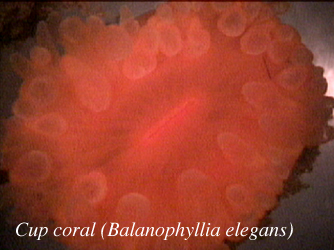
Holoplankton,
for example, are planktonic their entire lives, while meroplankton
spend only a part of their life cycle in the water column, usually as a
larval stage. The planktonic larval stages of invertebrate animals often
look very different from the non-planktonic adults. After a period of hours
to weeks to months in the plankton, larvae settle on a surface and metamorphose
into their more familiar adult forms, such as the cup coral pictured to
the left.
Corals, sea stars,
and bivalves can all have a planktonic larval stage (although the length
of time in the plankton may vary greatly, and some species do not have
a planktonic stage at all). Animals such as these that live on or associated
with the sea floor are called benthic. For organisms in which the adults
are also sessile (attached in one place), the planktonic larval stage may
represent the only possible mechanism for dispersal to new habitats.
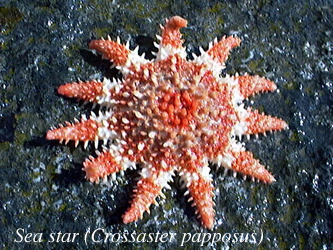 Size
is another way to categorize plankton. A common system uses the following
size classes (in millimeters):
Size
is another way to categorize plankton. A common system uses the following
size classes (in millimeters):
Picoplankton 0 - 0.002 mm
Ultraplankton 0.002 - 0.0055 mm
Nannoplankton 0.005 - 0.06 mm
Microplankton 0.06 - 0.5 mm
Mesoplankton 0.5 - 1.0 mm
Macroplankton 1.0 mm - 1.0 cm
Megaloplankton greater than 1.0 cm
Finally, plankton can
be classified by the relationships among organisms. Organisms are assigned
to different groups (phyla) based on certain similarities in body plan.
A list of common invertebrate phyla found in the local plankton is at the
bottom of this page, with links to appropriate pages. For more information
about plankton specifically, and invertebrates in general, see our page
of references.
Plankton
Collection and Observation
Collecting plankton
can be as simple as dipping a jar into the water off a dock, or as complicated
as towing large nets of varying mesh sizes behind a ship in the middle
of the ocean; sampling can be done at different geographic locations, depths,
and time of day.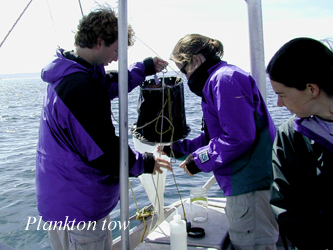 Because our primary goal was to survey the diversity of organisms in the
waters near the Friday Harbor Labs, we sampled mostly in the harbor from
a small boat (the Auklet), and from the lab dock (follow this link for
more information about Puget
Sound). Even without a complex sampling program, we were able to see
some patterns in the distribution and abundance of different types of plankton
(described in our Field and Lab
Notebook). After each plankton collecting trip, we brought the samples
back to the lab to view them under a microscope.
Because our primary goal was to survey the diversity of organisms in the
waters near the Friday Harbor Labs, we sampled mostly in the harbor from
a small boat (the Auklet), and from the lab dock (follow this link for
more information about Puget
Sound). Even without a complex sampling program, we were able to see
some patterns in the distribution and abundance of different types of plankton
(described in our Field and Lab
Notebook). After each plankton collecting trip, we brought the samples
back to the lab to view them under a microscope.
Plankton
Ecology
Although the immense
diversity of body plans and life cycles found in the plankton can seem
overwhelming, it is encouraging to recognize that all organisms must accomplish
similar goals: survival, growth, and reproduction. For this reason, we
have focused on four themes concerning how organisms in the plankton relate
to their habitat, and to each other. The same four themes are discussed
by other class groups for adult forms of marine invertebrates in various
benthic habitats around the island (rocky intertidal/tide pools, mud flats,
floating docks, and a subtidal creek). Click on the following links to
read about the four themes in the planktonic environment:
Feeding Locomotion Reproduction Defense
Local
Invertebrate Groups in the Plankton
The following are phyla
for which we have pictures of representative organisms that we found in
the plankton. This is by no means an exhaustive list, and is only intended
to provide a sense of the amazing diversity of planktonic marine invertebrates
that exists in the waters around San Juan Island!
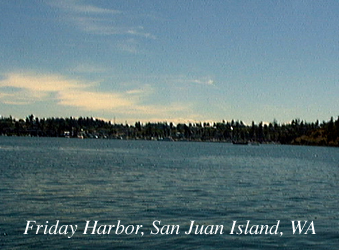
Conclusions
Lesson
Plan
About
Team Plankton
References
and Links